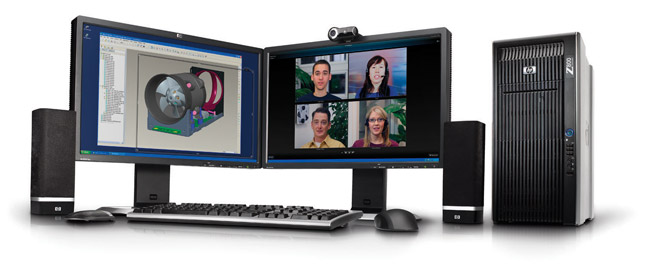Video conferencing and real-time collaboration for 3D CAD is the name of the game with HP’s long awaited SkyRoom. It is an exciting debut, but Greg Corke is already calling out for Version 2.0.
A few years back ‘collaboration’ was THE marketing buzzword. Joe collaborated with Jane and Jane collaborated with Jack — all using the latest collaborative design software. Today, while the hype has settled down and CAD software companies have new marketing check boxes to tick, one may argue that the ‘c’ word has never been more relevant.
Restrictions on business travel — for economic or environmental reasons — mean that the ability to collaborate effectively with geographically dispersed colleagues is becoming increasingly important. While video conferencing and online collaboration tools have been around for over a decade, with its new SkyRoom technology HP thinks it has something special on its hands.
Information
Product: SkyRoom
Supplier: HP
Price free with any HP workstation.
£100 for standalone license
hp.com/go/hpskyroom
SkyRoom provides a collaborative design environment where users can share desktops and talk face to face with extended design teams using standard PC webcams and microphones. While mainstream tools like Microsoft Meeting and GoToMeeting already offer this type of functionality, HP believes it has the edge when it comes to working with interactive 3D datasets. In order to maintain the smooth appearance of 3D models when they are manipulated on screen, a huge amount of data needs to be sent and it needs to be sent quickly and processed efficiently.
Remote Graphics software
Sending vast amounts of information through the ether to different locations is no trivial task and this is where HP’s Remote Graphics Software (RGS) comes into play. Originally designed to send data back from Mars, the technology uses highly efficient compression algorithms to stream pixel data.
Starting off on the presenter’s machine SkyRoom works by monitoring and updating only changes in screen appearance — not the entire display — then compresses the information before sending it to the participants, where it is decompressed and updated. In this way network traffic is said to be greatly reduced.
HP is focusing the technology on local networks but the reach of SkyRoom can also be extended beyond the firewall using Virtual Private Networks (VPNs) and work on expanding this to any TCP/IP connection is already under way.
Obviously bandwidth is an issue and at 300-400k/sec (up and down), the minimum requirements for SkyRoom are not trivial. As the compression algorithm is multi-threaded, multi core PCs are also required. However, powerful 3D graphics cards are not mandatory in every machine. As SkyRoom only streams 2D pixel data and not 3D vector data, it is only the host workstation that needs a 3D CAD-capable graphics card. The participant’s machines just need a 2D graphics card capable of playing HD video.
SkyRoom’s use of 2D pixel data also has added security benefits. Because intelligent vector-based CAD geometry is never shared, confidential data will not ‘accidentally’ fall into the wrong hands.
Setting up a collaborative session is incredibly easy to do. The presenter can invite up to three team members from a ‘buddy’ list and once they accept and face-to-face contact has been established the host ‘ring fences’ an area on his or her desktop to share. This could be a simple document or the modelling window in a 3D application. The view inside this ‘bounding box’ is then displayed on each participant’s screen and constantly updated in real time. In demonstrations we have seen over local networks there is no discernible lag and both the 3D model and streamed video are incredibly smooth. However, these were canned demos and we have yet to see this technology in action over VPN.
One of the most attractive things about SkyRoom is that it comes free with every new HP workstation. However, SkyRoom is not limited to HP hardware and is compatible with most dual core Windows machines regardless of brand. In this case it is available for purchase for £100 per seat.
Limitations
While SkyRoom’s beauty is certainly in its simplicity, there are some significant limitations when it comes to collaborating effectively. Participants can not take control of the host’s keyboard and mouse, and there are no markup tools available. These omissions are certain to make it hard for participants to discuss specific parts or design elements, and feedback is limited to verbal instructions. In addition, as the software can only be used externally using VPN, careful planning will be required to make sure all design, engineering and supply chain participants can be hooked up to the system.
Conclusion
Ever since HP launched its Remote Graphics Software (RGS) it has been crying out for someone to get their claws into it and turn it into a marketable tool for collaborative design. This has now happened with HP SkyRoom, where up to four participants can collaborate on a design and experience the benefits of a face-to-face meeting, albeit a virtual face-to-face meeting.
While this initial release shows much promise it is still a way off from being the finished product. Face-to-face discussions are certainly an important element of collaboration, but SkyRoom lacks those all-important tools required to get every participant directly involved with the 3D geometry, though we are told this will be addressed in future releases.
Despite its limitations, SkyRoom is still an interesting technology — and becomes even more so when you consider it comes free with every new HP workstation.
At a time where users are looking to get more out of their technology, this is a certainly a major value add for HP in the increasingly competitive workstation sector.






